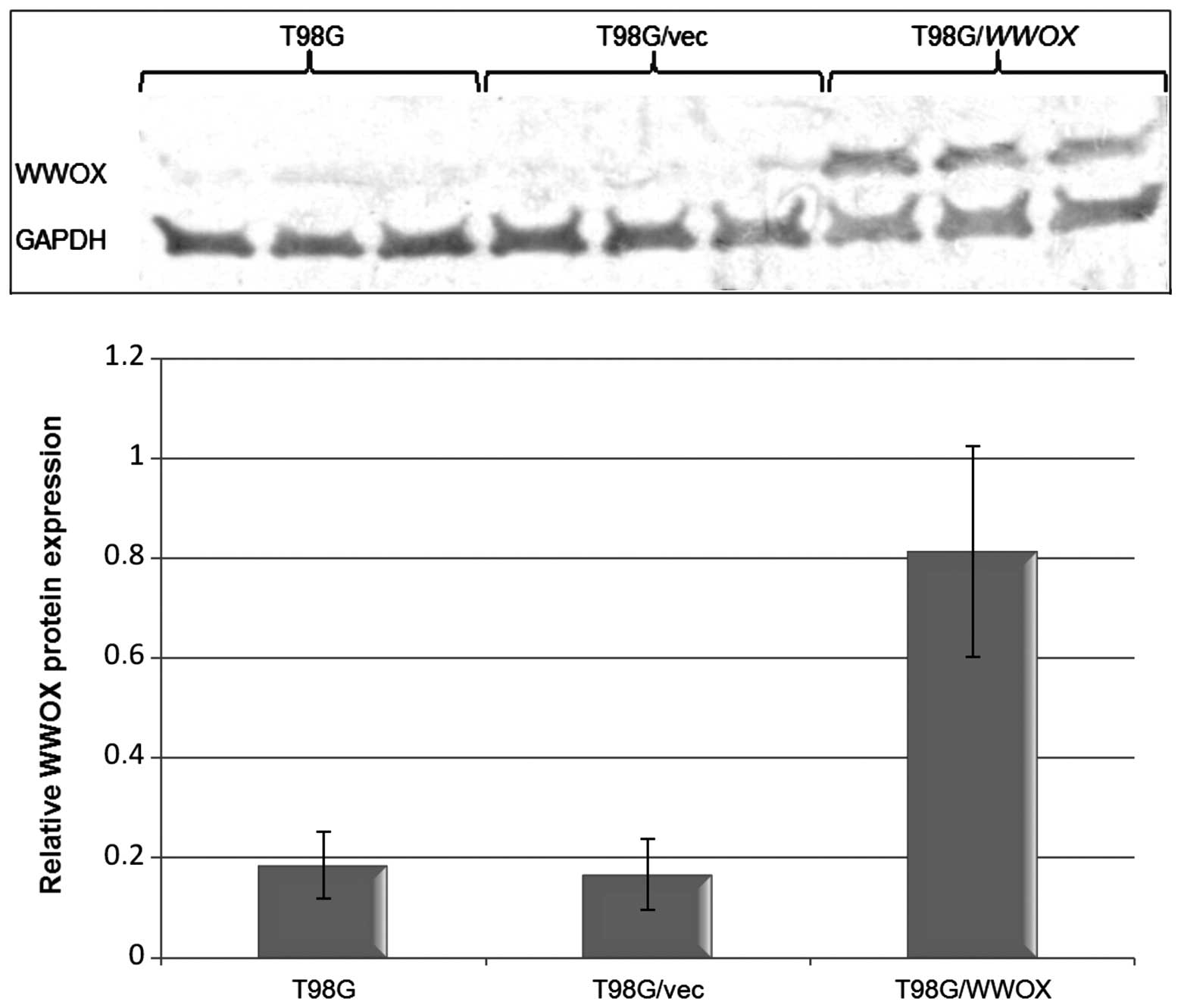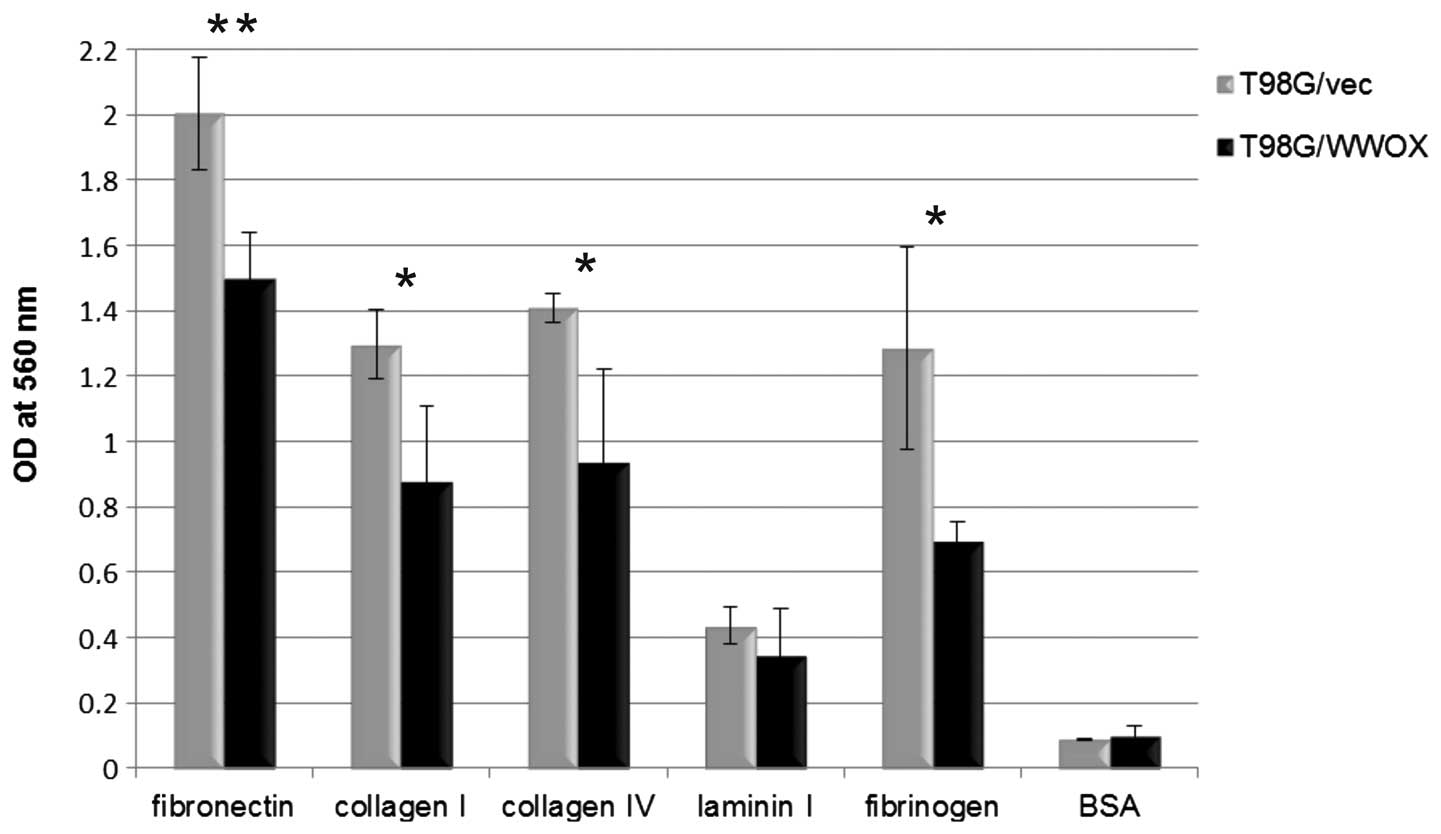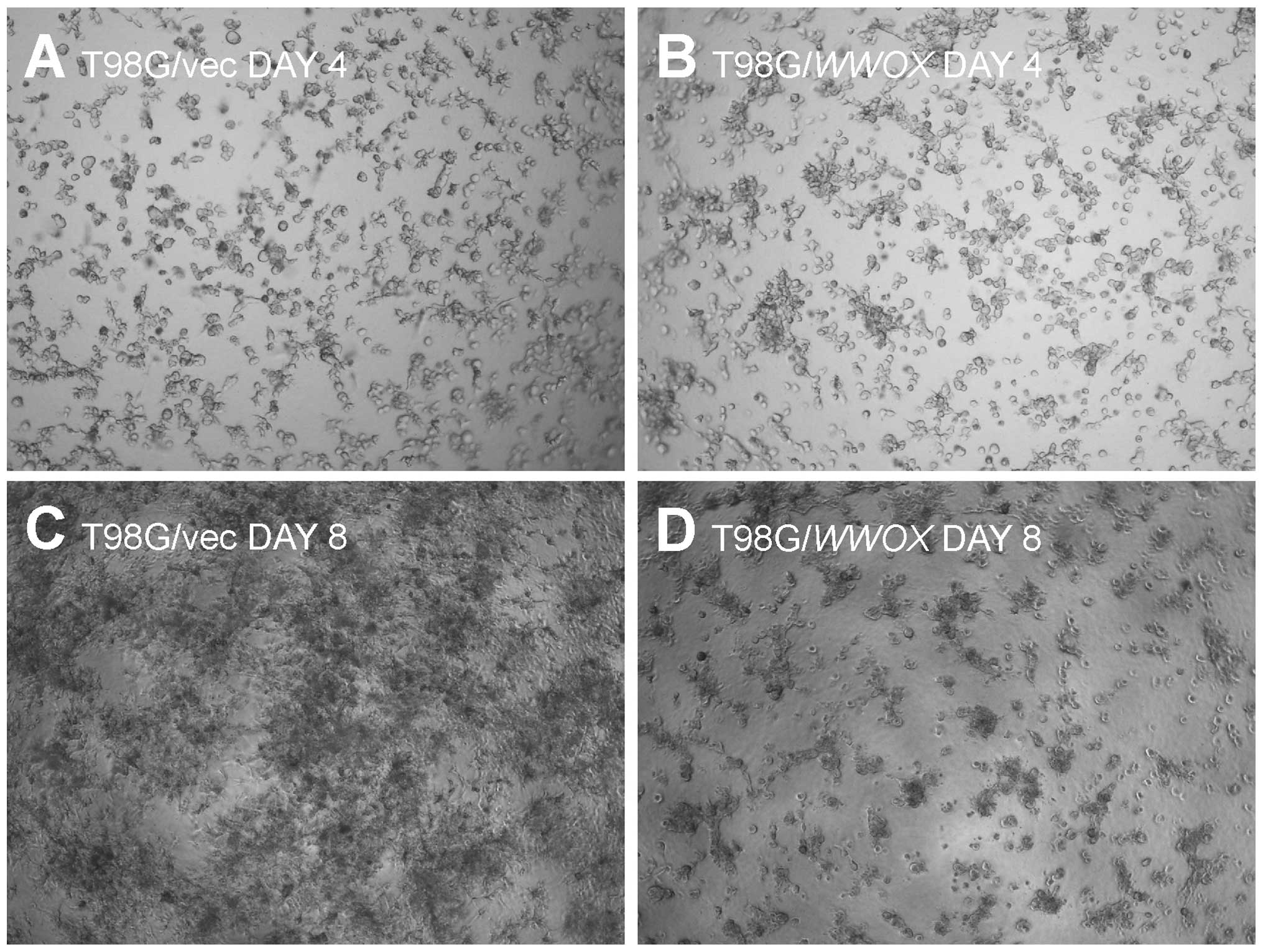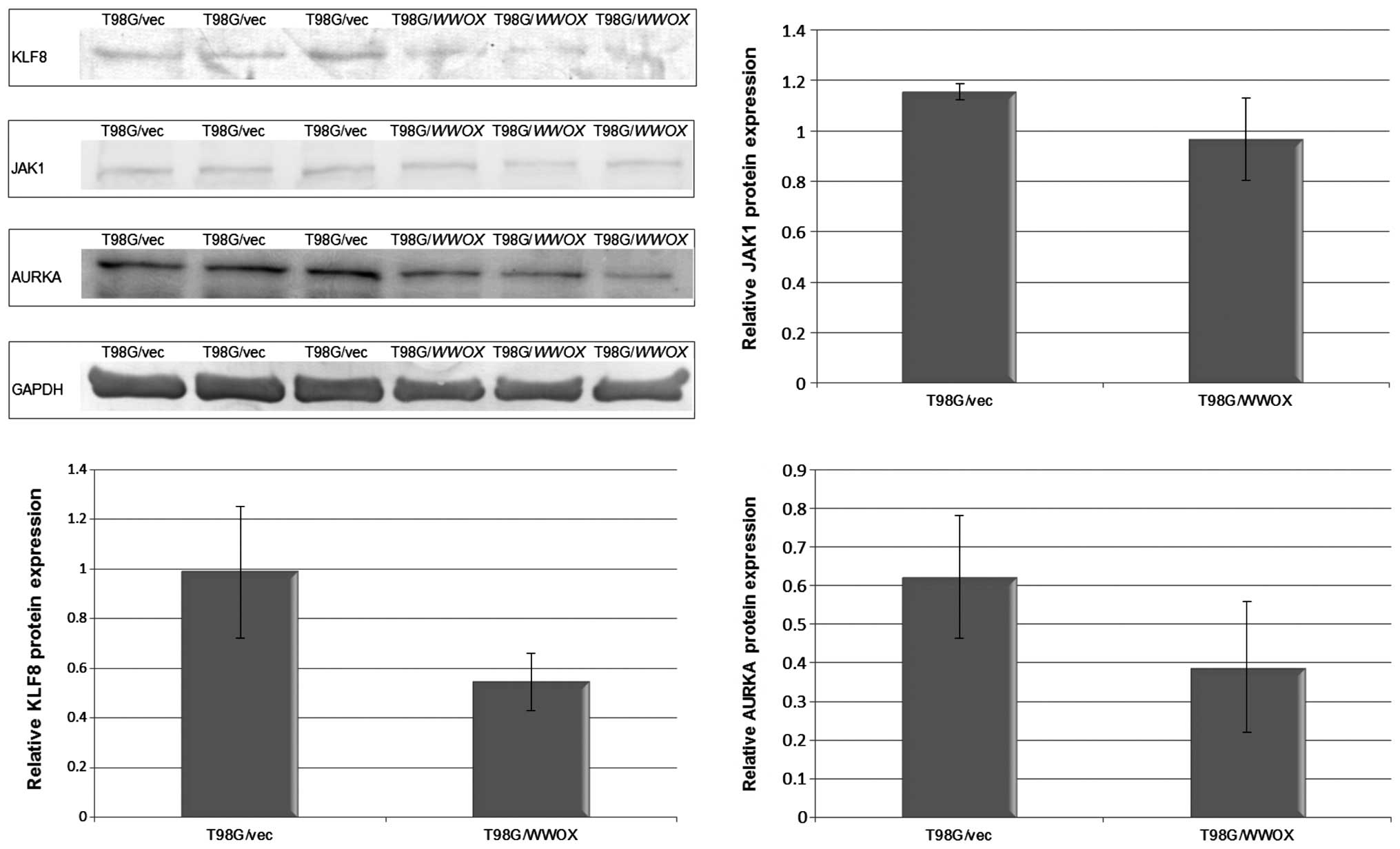|
1
|
Chen J and Xu T: Recent therapeutic
advances and insights of recurrent glioblastoma multiforme. Front
Biosci (Landmark Ed). 18:676–684. 2013. View Article : Google Scholar : PubMed/NCBI
|
|
2
|
Lwin Z, MacFadden D, Al-Zahrani A, et al:
Glioblastoma management in the temozolomide era: have we improved
outcome? J Neurooncol. 115:303–310. 2013. View Article : Google Scholar : PubMed/NCBI
|
|
3
|
Kanu OO, Hughes B, Di C, et al:
Glioblastoma multiforme oncogenomics and signaling pathways. Clin
Med Oncol. 3:39–52. 2009.PubMed/NCBI
|
|
4
|
Bednarek AK, Laflin KJ, Daniel RL, Liao Q,
Hawkins KA and Aldaz CM: WWOX, a novel WW domain-containing protein
mapping to human chromosome 16q23.3–24.1, a region frequently
affected in breast cancer. Cancer Res. 60:2140–2145.
2000.PubMed/NCBI
|
|
5
|
Aqeilan RI, Trapasso F, Hussain S, et al:
Targeted deletion of Wwox reveals a tumor suppressor
function. Proc Natl Acad Sci USA. 104:3949–3954. 2007.PubMed/NCBI
|
|
6
|
Aqeilan RI, Palamarchuk A, Weigel RJ,
Herrero JJ, Pekarsky Y and Croce CM: Physical and functional
interactions between the Wwox tumor suppressor protein and the
AP-2gamma transcription factor. Cancer Res. 64:8256–8261. 2004.
View Article : Google Scholar : PubMed/NCBI
|
|
7
|
Aqeilan RI, Pekarsky Y, Herrero JJ, et al:
Functional association between Wwox tumor suppressor protein and
p73, a p53 homolog. Proc Natl Acad Sci USA. 101:4401–4406. 2004.
View Article : Google Scholar : PubMed/NCBI
|
|
8
|
Aqeilan RI, Donati V, Palamarchuk A, et
al: WW domain-containing proteins, WWOX and YAP, compete for
interaction with ErbB-4 and modulate its transcriptional function.
Cancer Res. 65:6764–6772. 2005. View Article : Google Scholar : PubMed/NCBI
|
|
9
|
Matteucci E, Bendinelli P and Desiderio
MA: Nuclear localization of active HGF receptor Met in aggressive
MDA-MB231 breast carcinoma cells. Carcinogenesis. 30:937–945. 2009.
View Article : Google Scholar : PubMed/NCBI
|
|
10
|
Kosla K, Pluciennik E, Kurzyk A, et al:
Molecular analysis of WWOX expression correlation with
proliferation and apoptosis in glioblastoma multiforme. J
Neurooncol. 101:207–213. 2011.
|
|
11
|
Pfaffl MW, Horgan GW and Dempfle L:
Relative expression software tool (REST) for group-wise comparison
and statistical analysis of relative expression results in
real-time PCR. Nucleic Acids Res. 30:e362002. View Article : Google Scholar : PubMed/NCBI
|
|
12
|
Borges KS, Castro-Gamero AM, Moreno DA, et
al: Inhibition of Aurora kinases enhances chemosensitivity to
temozolomide and causes radiosensitization in glioblastoma cells. J
Cancer Res Clin Oncol. 138:405–414. 2012. View Article : Google Scholar : PubMed/NCBI
|
|
13
|
Lehman NL, O’Donnell JP, Whiteley LJ, et
al: Aurora A is differentially expressed in gliomas, is associated
with patient survival in glioblastoma and is a potential
chemotherapeutic target in gliomas. Cell Cycle. 11:489–502. 2012.
View Article : Google Scholar : PubMed/NCBI
|
|
14
|
Samaras V, Stamatelli A, Samaras E, et al:
Comparative immunohistochemical analysis of aurora-A and aurora-B
expression in human glioblastomas. Associations with proliferative
activity and clinicopathological features. Pathol Res Pract.
205:765–773. 2009. View Article : Google Scholar
|
|
15
|
Schnell O, Romagna A, Jaehnert I, et al:
Kruppel-like factor 8 (KLF8) is expressed in gliomas of different
WHO grades and is essential for tumor cell proliferation. PLoS One.
7:e304292012. View Article : Google Scholar : PubMed/NCBI
|
|
16
|
Tu Y, Zhong Y, Fu J, et al: Activation of
JAK/STAT signal pathway predicts poor prognosis of patients with
gliomas. Med Oncol. 28:15–23. 2011. View Article : Google Scholar : PubMed/NCBI
|
|
17
|
Aderca I, Moser CD, Veerasamy M, et al:
The JNK inhibitor SP600129 enhances apoptosis of HCC cells induced
by the tumor suppressor WWOX. J Hepatol. 49:373–383. 2008.
View Article : Google Scholar : PubMed/NCBI
|
|
18
|
Fabbri M, Iliopoulos D, Trapasso F, et al:
WWOX gene restoration prevents lung cancer growth in vitro
and in vivo. Proc Natl Acad Sci USA. 102:15611–15616. 2005.
View Article : Google Scholar
|
|
19
|
Hu BS, Tan JW, Zhu GH, Wang DF, Zhou X and
Sun ZQ: WWOX induces apoptosis and inhibits proliferation of
human hepatoma cell line SMMC-7721. World J Gastroenterol.
18:3020–3026. 2012. View Article : Google Scholar : PubMed/NCBI
|
|
20
|
Iliopoulos D, Fabbri M, Druck T, Qin HR,
Han SY and Huebner K: Inhibition of breast cancer cell growth in
vitro and in vivo: effect of restoration of Wwox expression. Clin
Cancer Res. 13:268–274. 2007. View Article : Google Scholar : PubMed/NCBI
|
|
21
|
Kuroki T, Yendamuri S, Trapasso F, et al:
The tumor suppressor gene WWOX at FRA16D is involved
in pancreatic carcinogenesis. Clin Cancer Res. 10:2459–2465.
2004.
|
|
22
|
Qin HR, Iliopoulos D, Semba S, et al: A
role for the WWOX gene in prostate cancer. Cancer Res.
66:6477–6481. 2006.PubMed/NCBI
|
|
23
|
Xiong Z, Hu S and Wang Z: Cloning of WWOX
gene and its growth-inhibiting effects on ovarian cancer cells. J
Huazhong Univ Sci Technolog Med Sci. 30:365–369. 2010. View Article : Google Scholar : PubMed/NCBI
|
|
24
|
Zhang P, Jia R, Ying L, et al:
WWOX-mediated apoptosis in A549 cells mainly involves the
mitochondrial pathway. Mol Med Rep. 6:121–124. 2012.
|
|
25
|
Chiang MF, Yeh ST, Liao HF, Chang NS and
Chen YJ: Overexpression of WW domain-containing oxidoreductase WOX1
preferentially induces apoptosis in human glioblastoma cells
harboring mutant p53. Biomed Pharmacother. 66:433–438. 2012.
View Article : Google Scholar
|
|
26
|
Lewandowska U, Zelazowski M, Seta K,
Byczewska M, Pluciennik E and Bednarek AK: WWOX, the tumour
suppressor gene affected in multiple cancers. J Physiol Pharmacol.
60:47–56. 2009.PubMed/NCBI
|
|
27
|
Nowakowska M, Pospiech K, Lewandowska U,
Piastowska-Ciesielska AW and Bednarek AK: Diverse effect of WWOX
overexpression in HT29 and SW480 colon cancer cell lines. Tumour
Biol. View Article : Google Scholar : 2014.PubMed/NCBI
|
|
28
|
Abdeen SK, Salah Z, Khawaled S and Aqeilan
RI: Characterization of WWOX inactivation in murine mammary gland
development. J Cell Physiol. 228:1391–1396. 2013. View Article : Google Scholar : PubMed/NCBI
|
|
29
|
O’Brien J, Wilson I, Orton T and Pognan F:
Investigation of the Alamar Blue (resazurin) fluorescent dye for
the assessment of mammalian cell cytotoxicity. Eur J Biochem.
267:5421–5426. 2000.PubMed/NCBI
|
|
30
|
O’Keefe LV, Colella A, Dayan S, et al:
Drosophila orthologue of WWOX, the chromosomal fragile site
FRA16D tumour suppressor gene, functions in aerobic metabolism and
regulates reactive oxygen species. Hum Mol Genet. 20:497–509.
2011.
|
|
31
|
Dayan S, O’Keefe LV, Choo A and Richards
RI: Common chromosomal fragile site FRA16D tumor suppressor WWOX
gene expression and metabolic reprograming in cells. Genes
Chromosomes Cancer. 52:823–831. 2013. View Article : Google Scholar : PubMed/NCBI
|
|
32
|
Wolf A, Agnihotri S and Guha A: Targeting
metabolic remodeling in glioblastoma multiforme. Oncotarget.
1:552–562. 2010.PubMed/NCBI
|
|
33
|
Gourley C, Paige AJ, Taylor KJ, et al:
WWOX gene expression abolishes ovarian cancer tumorigenicity in
vivo and decreases attachment to fibronectin via integrin alpha3.
Cancer Res. 69:4835–4842. 2009. View Article : Google Scholar : PubMed/NCBI
|
|
34
|
Morin PJ: Drug resistance and the
microenvironment: nature and nurture. Drug Resist Updat. 6:169–172.
2003. View Article : Google Scholar : PubMed/NCBI
|
|
35
|
Giese A, Laube B, Zapf S, Mangold U and
Westphal M: Glioma cell adhesion and migration on human brain
sections. Anticancer Res. 18:2435–2447. 1998.PubMed/NCBI
|
|
36
|
Brieher WM and Yap AS: Cadherin junctions
and their cytoskeleton(s). Curr Opin Cell Biol. 25:39–46. 2013.
View Article : Google Scholar : PubMed/NCBI
|
|
37
|
Vitriol EA and Zheng JQ: Growth cone
travel in space and time: the cellular ensemble of cytoskeleton,
adhesion, and membrane. Neuron. 73:1068–1081. 2012. View Article : Google Scholar : PubMed/NCBI
|













